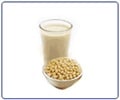Health Implications of Soy
Soya Isoflavones
Isoflavones are a class of phytoestrogens with weak estrogenic activity and soy is the richest source of isoflavones in the diet.
In soybeans, isoflavones are present as glycosides (bound to a sugar molecule) and fermentation or digestion of soy results in the release of the sugar molecule from the isoflavone glycoside, leaving an isoflavone aglycone. Soy isoflavone glycosides are called genistin, daidzin, and glycitin, while the active aglycones are called genistein, daidzein, and glycitein
The biological effects of soy isoflavones are strongly influenced by their metabolism, which is dependent on the activity of bacteria in the human intestine.
Many of the beneficial effects of soy foods are thought to be related to the presence of phytoestrogens. Phytoestrogens act in a similar way to the hormone estrogen, although they are far less potent. It is thought that phytoestrogens can have a normalizing effect on the body’s natural estrogen levels. When estrogen levels are low, as in postmenopausal women, the weak effect of phytoestrogens can return the body’s estrogen to more normal levels and so relieve menopausal symptoms. They help reduce the cholesterol too and are heart protective.
Tofu, tempeh and soy milk are good sources of phyto-oestrogens. An amount ranging between 30-50mg of isoflavones per day is enough to offer health benefits.
| Food | Total Isoflavone (mg/100g) |
| Soy beans Tofu Tempeh Soy milk | 2-221 4-67 103 1-21 |
Disease Prevention
Benefits Heart Health
Consumption of soy protein in place of animal protein has been found to reduce serum concentrations of total cholesterol, LDL cholesterol and triglycerides. The precise mechanism is not clear, though several theories exist. One theory proposes that cholesterol absorption is impaired. Whereas another theory proposes that phytoestrogens bind to estrogen receptors and produce similar effects including lowering LDLs and increasing HDL cholesterol.
Consumption of about 25 grams of soy protein or more each day can reduce the bad cholesterol. Twenty-five grams of soy protein equals 1¼ cups of tofu, 1–2 cups of soymilk, or an ounce of soy flour. Food labels should be read in order to verify a particular food's soy content. The U.S. Food and Drug Administration (FDA) has long before approved the health claim for the relationship between soy product consumption and reduced risk of
Helps Control Diabetes, Obesity
Various studies show that soy protein has been effective in controlling hyperglycemia, hyperlipidemia, and hyperinsulinemia. These characteristics aid in the control of obesity and blood sugar.
For Stronger Bones
Studies have found that supplementing the diet of postmenopausal women with 40 grams of soy protein (containing 80mg to 90mg of soya isoflavones) a day for six months and longer could reduce bone loss and increase the bone mineral content and density of the lumbar spine. Diets rich in phytoestrogens (and therefore isoflavones) are likely to benefit bone health.
Studies from Japan and China have shown that postmenopausal women with the highest intake of isoflavone-rich soy foods have the highest bone mineral density in the lumbar spine compared with women with low intakes of soy.
Good Calcium Source
With food digestion, acids are released into the blood in varying proportions, depending on the food consumed. The body neutralizes these acids by drawing calcium from bones which is then excreted in the urine.
Animal protein from cow’s milk, dairy products, meat, fish and eggs, have a strong acidic effect compared to plant protein sources like legumes, pulses, soybean because of the sulphur-containing amino acids in them. With the consumption of increasing amounts of animal products, the sulphur content of the diet increases and so does the level of calcium in the urine. This increases calcium loss and may be a risk factor for the development of weak bones. As milk is high in calcium, it is postulated as one of the richest sources of the mineral. The World Health Organisation (WHO) calls this the ‘calcium paradox’, where the damaging effects of animal protein may outweigh the positive effects of the calcium it contains (WHO, 2004). Therefore it becomes a good idea to also focus on consuming protein and calcium rich plant foods. In such a case, soy milk stands tall as it is rich in protein and fortified with calcium too. Apart from above soy benefits, isoflavones are good for bone health as well.
Cancer Prevention
Genistein, one of the phytochemicals found in soy, can reduce the risk of cancer. Prevention of breast cancer and prostate cancer has received the most attention. Genistein blocks cancer development by preventing tumors from creating blood vessels that would provide nourishment for growth. One serving a day (1 cup of soymilk, ½ cup of tofu or soybeans) has shown to be effective for cancer prevention.
Relieves Menopausal Symptoms
Phytoestrogens are being researched to determine their usefulness in acting like synthetic estrogen to protect women from bone loss and maintain a healthy heart. Soy protein has been found to positively influence bone and calcium balance in postmenopausal women.







